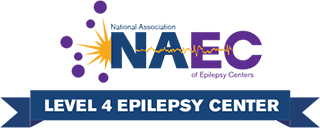
Epilepsy
If you live with epilepsy, uncontrolled seizures are devastating. We never give up on our patients and offer advanced, leading-edge treatment options.
As a top-rated Level 4 epilepsy center, UCI Health delivers outstanding surgical and non-surgical results.
Epilepsy symptoms
Epilepsy is a long-term but treatable condition caused by abnormal brain signals, leading to unpredictable seizures that can range from mild to life-threatening and disrupt daily life. However, not all seizures are caused by epilepsy.
Typical seizure symptoms include repetitive episodes of one or a combination of the following:
- Convulsions (generalized shaking movements with loss of awareness)
- Episodes of losing track of time
- Staring blankly without awareness
- Loss of consciousness, then falling
- Body stiffening
- Loss of bladder control and or tongue/lip bites
- Episodic Confusion
- Frequent episodes of a sensation of deja vu, dread or fear
- Nocturnal episodes of abnormal movements or odd behaviors
When to seek care for epilepsy
Epilepsy can occur at any age. If you have a seizure or seizure symptoms for the first time, it’s important to see your doctor.
If your epileptic seizure lasts longer than three minutes, call 911. Go to the emergency room if the seizure results in trouble breathing, waking up, or getting injured while having convulsions.
Visit our Epilepsy Care center. When you come for your appointment, please bring copies of your medical records, including your EEG and MRI results.

We care for even the most challenging epilepsy cases
Our epilepsy program is nationally ranked, and our tests, treatments and specialists are top tier. Let us help bring you relief from this difficult condition.
Call 714-456-6203 now to speak with an epilepsy specialist, or

Find a neurology clinical trial
Talk to your doctor to see if a neurology clinical trial is right for you.
Types of epileptic seizure
Focal epilepsy is a seizure that starts in one specific area of your brain. Focal seizures last from a few seconds to several minutes. A focal seizure that then spreads throughout your brain is called a secondarily generalized seizure.
Generalized seizures affect both sides of your brain. They may last from seconds to minutes.
Patients with epilepsy (unprovoked seizures) can experience one or more of these types of seizures:
- Petite mal (aka absence seizures)
- Grand mal (aka tonic-clonic seizures)
- Tonic seizures
- Clonic seizures
- Myoclonic seizures
- Atonic seizures
People who only experience provoked seizures don’t have epilepsy. Provoked seizures are not caused by a brain disease or disorder. Some causes of provoked seizures include:
- High fever
- Dehydration
- Excessive alcohol or stimulants
- A metabolic cause such as low sodium levels in the blood
Causes of seizures
Epilepsy always causes seizures, but having a seizure doesn’t automatically mean you have epilepsy.
We classify seizures by what causes them.
- Symptomatic — this means that the cause is unknown and not genetic
- Idiopathic — genetic factors are involved
- Cryptogenic — the cause is unknown
Epilepsy diagnosis at UCI Health
UCI Health is a Level 4 designation, the highest level awarded by the National Association of Epilepsy Centers, recognizing our access to the most advanced testing and treatment tools available. These include:
- In-hospital video EEG monitoring
- Advanced MRI and PET imaging studies
- Laser surgery
- Implantable medical devices to treat difficult to control epilepsy.
The first step is a preliminary epilepsy diagnosis, after which your doctor will prescribe tests tailored to your unique case including:
- New patient questionnaire about your seizure history
- Physical exam
- Blood test
- Brain imaging: MRI, PET, CT, MEG or SPECT scan
- Neurological exam
- Neuropsychological test
- Routine EEG
- 24-hour ambulatory EEG
We perform EEG tests to confirm or characterize seizures, to prepare for surgery or before receiving a neurostimulator.
Diagnosing epilepsy for surgery
Our team will assess your seizure type to decide if surgery is a safe option for you. Surgery can remove the damaged tissue causing seizures, potentially curing the condition or reducing their severity.
If you are a surgical candidate, we’ll monitor your seizures to map your brain. This could include:
- Admission to the UCI Health epilepsy monitoring unit
- Wada test
EEG and MRI or PET scans
These tell us which side of the brain a seizure is coming from. Before surgery, your doctors will map your brain using implanted (intracranial) electrodes. Intracranial monitoring locates the exact part of the brain producing the seizures.
Subdural electrode monitoring (SGDE)
SGDE involves placing tiny electrodes on your brain's surface to record its electrical activity. While you’re under anesthesia, your surgeon makes small holes in your skull and inserts a strip of electrodes. We’ll monitor you in our epilepsy monitoring unit, recording your seizures for days or weeks.
Stereo-EEG (SEEG)
We use SEEG to find brain areas causing seizures that can't be detected with regular SGDE testing. The procedure is similar to SGDE. Instead of placing electrodes on the surface, we place them inside, listening for seizures deep within the brain tissue itself.
You won’t find this advanced level of diagnostic tools outside of an academic center.
Our clinicians
Epilepsy treatment at UCI Health
Our clinicians are dedicated to offering our community world class, personalized treatment. We understand how debilitating epilepsy is and treat your case with the care we’d give family members.
There are five primary treatments.
Medication
Our goal is to find medicine that eliminates or reduces your seizures with the fewest side effects. Like the majority of epilepsy patients, you may respond well to one or a combination of drugs. Some of you may be eligible to enroll in an experimental drug study.
Surgery
We understand that brain surgery can be intimidating. However, if two or three appropriate medications haven’t worked, other medications are unlikely to help. This makes you a potential candidate for epilepsy surgery. Options include:- removing the brain tissue causing seizures
- implanting brain stimulation devices (neurostimulation)
Vagus nerve stimulation (VNS)
The VNS is a small, adjustable device we place under your skin, usually in the chest area. It emits an electrical signal that stimulates the vagus nerve, which can stop or lessen seizures.
Most VNS patients see a decrease in seizures after the procedure.
Deep brain stimulation (DBS)
The DBS is also a small adjustable device we place under the skin in your chest. We implant small wires into the part of your brain called the thalamus that are connected to the device.
The device sends electrical signals via the wires. These signals are painless.
Responsive brain stimulation (RNS)
We implant the RNS device in your skull. It consists of a battery and sensors that monitor your brain’s activity. It is programmed to recognize abnormal brain activity and deliver electrical stimulation.
You won’t perceive or feel the stimulating signals. The device collects all the data and sends it to a computer. Your epilepsy specialist reviews this information and may use it to modify your treatment.
Additional treatments and services
- Clinical trials Dietary guidance
- Women’s epilepsy services
Why choose UCI Health for epilepsy care?
UCI Health has a six-bed epilepsy unit with advanced tools to monitor real-time seizure activity
We are one of the region’s only facilities equipped with instruments sensitive enough to capture sustained seizure activity. This lets us locate the source of your seizures so we can operate with precision.
We lead the region in our minimally invasive testing and treatment approaches
Minimally invasive approaches mean you spend less time in the hospital and recover faster. It also lowers the risk of complications like infections.
Our minimally invasive Stereo-EEG mapping process has a great success rate identifying the part of the brain triggering seizures in most patients.
Vagus nerve, deep brain and responsive brain stimulation are minimally invasive devices that can also reduce seizure frequency.
We evaluate more epilepsy patients than any other program in the region
The National Association of Epilepsy Centers recognized us as a Level 4 facility, the highest possible level of care. Treating such a high volume of patients refines and deepens our gifts. Ask us anything.
Our specialists are fellowship-trained in multiple disciplines
You’ll gain access to an extraordinary group of subspecialists all working seamlessly to enhance the quality of your daily life. Your epilepsy team would include specially trained epilepsy neurologists, radiologists, neuropsychologists, and epilepsy surgeons.
Our nurse navigators offer tremendous practical support
Daily life changes with epilepsy, including driving. Our nurse navigators will help you complete disability paperwork for the DMV.
They’ll spend time talking to you about medication side effects. They're also a great resource to teach your caregivers and loved ones how they can support you.
We're a National Association of Epilepsy Centers (NAEC) Level 4 Epilepsy Center

Featured News Stories

Leaders celebrate opening of UCI Health — Irvine





